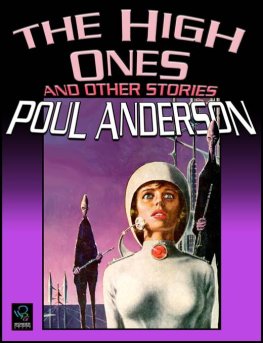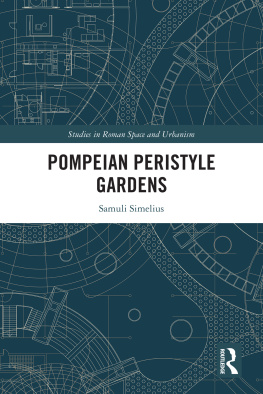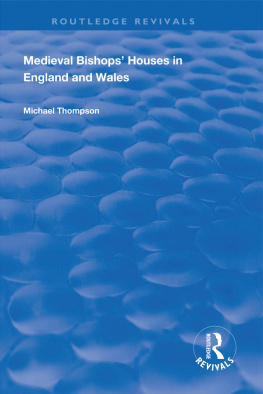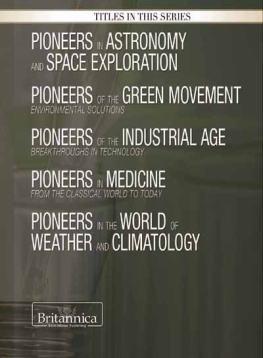Anderson Michael A. - Space, Movement, and Visibility in Pompeian Houses
Here you can read online Anderson Michael A. - Space, Movement, and Visibility in Pompeian Houses full text of the book (entire story) in english for free. Download pdf and epub, get meaning, cover and reviews about this ebook. year: 2023, publisher: Taylor & Francis Group, genre: Science fiction. Description of the work, (preface) as well as reviews are available. Best literature library LitArk.com created for fans of good reading and offers a wide selection of genres:
Romance novel
Science fiction
Adventure
Detective
Science
History
Home and family
Prose
Art
Politics
Computer
Non-fiction
Religion
Business
Children
Humor
Choose a favorite category and find really read worthwhile books. Enjoy immersion in the world of imagination, feel the emotions of the characters or learn something new for yourself, make an fascinating discovery.

- Book:Space, Movement, and Visibility in Pompeian Houses
- Author:
- Publisher:Taylor & Francis Group
- Genre:
- Year:2023
- Rating:5 / 5
- Favourites:Add to favourites
- Your mark:
- 100
- 1
- 2
- 3
- 4
- 5
Space, Movement, and Visibility in Pompeian Houses: summary, description and annotation
We offer to read an annotation, description, summary or preface (depends on what the author of the book "Space, Movement, and Visibility in Pompeian Houses" wrote himself). If you haven't found the necessary information about the book — write in the comments, we will try to find it.
Space, Movement, and Visibility in Pompeian Houses — read online for free the complete book (whole text) full work
Below is the text of the book, divided by pages. System saving the place of the last page read, allows you to conveniently read the book "Space, Movement, and Visibility in Pompeian Houses" online for free, without having to search again every time where you left off. Put a bookmark, and you can go to the page where you finished reading at any time.
Font size:
Interval:
Bookmark:
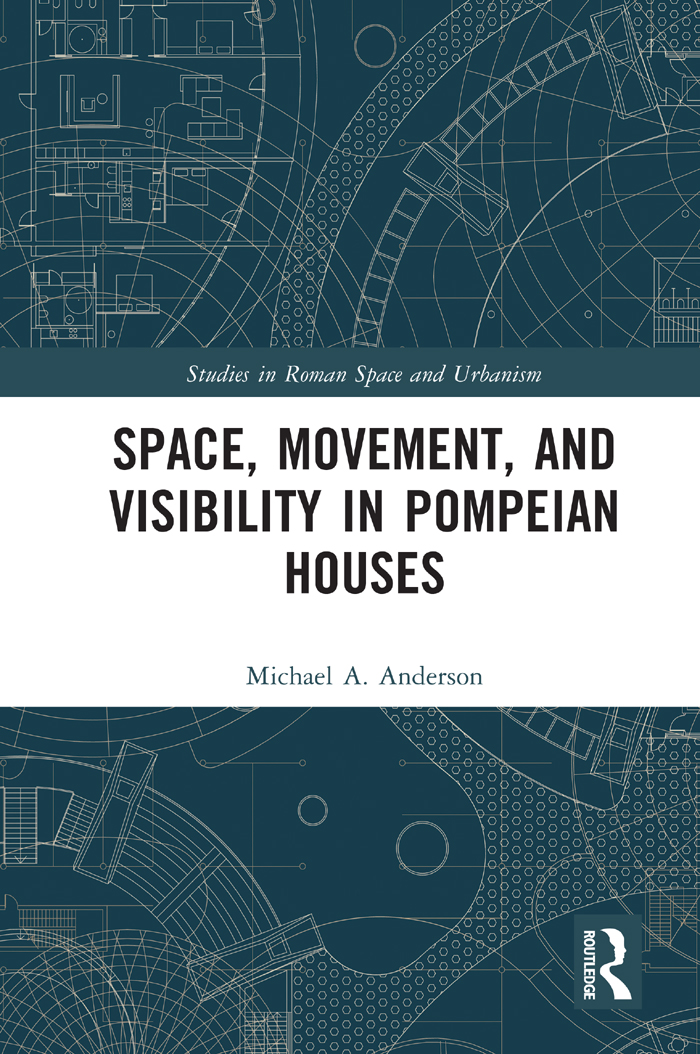
This volume examines the pivotal role of movement, visibility, and experience within Pompeian houses as a major factor determining house form; the use of space; and the manner, meaning, and modalities of domestic daily life, through the application of GIS-based analysis.
Through close consideration of ancient literature, detailed explanations of methodology, and exploration of results, Michael Anderson provides new perspectives on Pompeian domestic space including room types and household activities that rarely feature in the discussion of ancient housing. Readers gain a better understanding of priorities in the design of Pompeian houses, the degree to which daily life was interrupted by earthquake damage in the sites final years, and evolving motivations behind wall painting decoration. The volume not only explores how Pompeian houses reflected the needs of everyday life as imagined by their architects, but also how these spaces served to influence and control daily activities and ultimately how they were transformed by the spatial and visual requirements of domestic life.
Space, Movement, and Visibility in Pompeian Houses is suitable for students and scholars of Pompeian houses and domestic life, Roman architecture and urbanism, and spatial analysis and space syntax.
Michael A. Anderson is Chair of Classics at San Francisco State University (USA) and Director of the Via Consolare Project in Pompeii. He is co-author of the House of the Surgeon, Pompeii: Excavations in the Casa del Chirurgo (VI 1, 9-10.23) (2018).
Series editor: Ray Laurence
Macquarie University, Australia
Over the course of the last two decades, the study of urban space in the Roman world has progressed rapidly with new analytical techniques, many drawn from other disciplines such as architecture and urban studies, being applied in the archaeological and literary study of Roman cities. These dynamically interdisciplinary approaches are at the centre of this series. The series includes both micro-level analyses of interior spaces as well as macro-level studies of Roman cities (and potentially also wider spatial landscapes outside the city walls). The series encourages collaboration and debate between specialists from a wide range of study beyond the core disciplines of ancient history; archaeology; and Classics such as art history and architecture, geography and landscape studies, and urban studies. Ultimately, the series provides a forum for scholars to explore new ideas about space in the Roman city.
Space, Movement and the Economy in Roman Cities in Italy and Beyond
Edited by Frank Vermeulen and Arjan Zuiderhoek
Greek Cities and Roman Governors
Placing Power in Imperial Asia Minor
Garrett Ryan
Rethinking the Roman City
The Spatial Turn and the Archaeology of Roman Italy
Edited by Dunia Filippi
Urban Space and Urban History in the Roman World
Edited by Miko Flohr
Pompeian Peristyle Gardens
Samuli Simelius
Space, Movement, and Visibility in Pompeian Houses
Michael A. Anderson
For further information about this series, please visit https://www.routledge.com/Studies-in-Roman-Space-and-Urbanism/book-series/SRSU
Michael A. Anderson

First published 2023
by Routledge
4 Park Square, Milton Park, Abingdon, Oxon OX14 4RN
and by Routledge
605 Third Avenue, New York, NY 10158
Routledge is an imprint of the Taylor & Francis Group, an informa business
2023 Michael A. Anderson
The right of Michael A. Anderson to be identified as author of this work has been asserted in accordance with sections 77 and 78 of the Copyright, Designs and Patents Act 1988.
All rights reserved. No part of this book may be reprinted or reproduced or utilised in any form or by any electronic, mechanical, or other means, now known or hereafter invented, including photocopying and recording, or in any information storage or retrieval system, without permission in writing from the publishers.
Trademark notice: Product or corporate names may be trademarks or registered trademarks, and are used only for identification and explanation without intent to infringe.
British Library Cataloguing-in-Publication Data
A catalogue record for this book is available from the British Library
Library of Congress Cataloguing-in-Publication Data
Names: Anderson, Michael A., 1974- author.
Title: Space, movement, and visibility in Pompeian houses / Michael A. Anderson.
Description: Abingdon, Oxon: Routledge, 2023. | Series: Studies in Roman space and urbanism | Includes bibliographical references and index.
Identifiers: LCCN 2022030151 (print) | LCCN 2022030152 (ebook) | ISBN 9781472485953 (hardback) | ISBN 9781032393391 (paperback) | ISBN 9781315610153 (ebook)
Subjects: LCSH: Architecture, Domestic--Italy--Pompeii (Extinct city) | Domestic space--Italy--Pompeii (Extinct city) | Pompeii (Extinct city)--Buildings, structures, etc.
Classification: LCC NA327.P6 A53 2023 (print) | LCC NA327.P6 (ebook) | DDC 722/.7--dc23/eng/20220719
LC record available at https://lccn.loc.gov/2022030151
LC ebook record available at https://lccn.loc.gov/2022030152
ISBN: 978-1-472-48595-3 (hbk)
ISBN: 978-1-032-39339-1 (pbk)
ISBN: 978-1-315-61015-3 (ebk)
DOI: 10.4324/9781315610153
Typeset in Times New Roman
by MPS Limited, Dehradun
For Mum and Dad
Before I had even begun my PhD research at the University of Cambridge, a wise Roman historian at UCLA, then in the process of publishing his own doctoral work, advised me not to wait a decade to bring it to publication. Appropriately counselled, I promised myself I would never allow the like to occur. However, an even longer span of time than that has now passed between the completion of my own thesis and the publication of the present volume. Whilst I confess that I should like to have finished it sooner, I am certain that the delay nevertheless has served to improve the work, which has continued to evolve in the meantime. Moreover, I am pleased to note that the results are yet able to contribute to the field of spatial studies in Roman archaeology, interest in which shows no sign of abating in the near future. In fact, given the recent shift in current scholarship away from the spatial turn and toward the multisensory, the research presented in this volume should be especially valuable, given its emphasis on the quantification of the spatial and visual experience of actors within the Pompeian domestic environment, a priority that may provide a starting point for similar work directed towards mapping the phenomenological experience of other senses.
This volume presents the synthesis of the observations and conclusions reached during my studies at Cambridge, combined with on-going research that has refined these results and led the work in several new directions. The analyses developed in the first instance have now been augmented, increased in resolution, and directed towards more specific types of questions. I have moved the focus away from my initial desire to identify statistically valid trends in a data set that was never really amenable to such goals, toward a greater emphasis on the exploration of the individual details and particulars of the built environment of each Pompeian house. I have also attempted to address as many of the of the observations and suggestions so generously offered by my examiners, Prof. Ezra Zubrow and Prof. Wallace-Hadrill, and my supervisor and advisors, Dr Simon Stoddart and Prof. Lord Colin Renfrew, to whom I am deeply indebted for their time and attention. Likewise, I would like to thank Dr Astrid Schoonhoven and Dr Damian Robinson for correcting and challenging my earlier drafts and ideas; as well as the series editor Prof. Ray Laurence and my colleague Dr Gill McIntosh for extensive and useful feedback on more recent versions. Their contributions have improved the work beyond measure; though naturally any errors yet remaining are entirely my own.
Font size:
Interval:
Bookmark:
Similar books «Space, Movement, and Visibility in Pompeian Houses»
Look at similar books to Space, Movement, and Visibility in Pompeian Houses. We have selected literature similar in name and meaning in the hope of providing readers with more options to find new, interesting, not yet read works.
Discussion, reviews of the book Space, Movement, and Visibility in Pompeian Houses and just readers' own opinions. Leave your comments, write what you think about the work, its meaning or the main characters. Specify what exactly you liked and what you didn't like, and why you think so.

